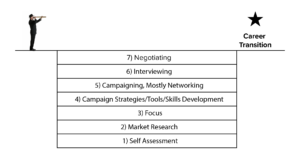Career Crossroads after 50…Preparing For What’s Next (Part 2)
March, 2018
This month I will discuss the steps that lead to a successful career transition or career transformation after age 50. By career transition, I mean a next step that has much in common with the career path you have already followed. By career transformation, I mean a major departure from the path you have been following most of your career.
Last month’s blog began with nine career alternatives at crossroads after age 50. Click this link to read the descriptions of these nine options, with corresponding financial implications and degree of difficulty for each.
I have observed and guided hundreds of transitions and transformations in my 29 years as a career coach. When my clients arrived at a career crossroads between ages 50 and 60, most have chosen a career transition.
Prior to age 60, we are still in our peak earning years. We have gained considerable expertise, built a compelling resume, and have income demands that fit with continuing on a familiar path a while longer. Additionally, we can tap our many connections and are a strong job candidate when we choose to continue in the same, or similar, field of work.
Path to a Successful Career Transition
To get started, I suggest you employ the Ronnie Brooks method. Brooks is one of the founders of the Wilder Foundation’s Shannon Institute, and has taught this method for many years. The graphic above is my interpretation of her model. You’ll need to build a platform leading to your preferred future from the bottom up. Brooks suggests that you imagine a steadily growing platform of mattresses you toss down from above.
To get to your preferred career transition destination on the right, you need to lay down a collection of platforms, or steps, to help get you there successfully. If you are currently employed, you will need to build your transition base from the bottom up with whatever spare time and energy you have for this task.
With each of the seven steps you will be building a foundation that leads to your exit and a new start as you create this transition bridge. While this process might seem laborious and time consuming, it will make your transition more methodical and less risky. Even with just a few mattresses tossed down, a safer transition becomes much more likely.
If you are already in a career transition, or decide to take the leap from your job before securing another one, imagine yourself at, or near, the bottom of this model. You will be building steps in the same order, and this becomes your primary job, building and climbing these steps until you have successfully arrived at your career transition.
In future blogs I will share career crossroads stories which demonstrate various ways these seven platforms can take shape. If you have experienced a career transition, these seven levels will be familiar. What is less familiar is how to create a bridge to a career transformation.
Path to a Successful Career Transformation
Between ages 60 and 75, career transformation becomes a much more likely focus. At some point in this stage of our life we wonder, “When can I get off this hamster wheel?” This becomes a time to shift away from traditional and familiar work and explore broader possiblities. Eventually in this 60 to 75 age range, most of us will wonder how to narrow, shift, or eliminate our paid work and at the same time broaden our world.
You can see in the illustration above how a career transformation process compares to a career transition process. Step one is the same in both models, employing a self assessment and career audit of your past and current skills, interests, values and fit. Here is a blog to help you with the career audit process: Living Life Forward, Understanding it Backwards
The Strong Interest Inventory assessment is a very helpful tool for naming new possibilities (step 2) that can be researched (step 3) through both the internet and informational interviews. You can purchase a $9.95 version of the Strong Interest Inventory through Self-Directed-Search.com.
The fourth and fifth steps in this process come from the book, Working Identity by Herminia Ibarra. For a detailed description of each of these steps, click to my past blogs: Shifting Connections & the Strength of Weak Ties and Crafting Experiments
After sufficient time spent with experiments and new connections, then it is time to see if the new direction being considered makes sense. If it does, continue moving forward. If it does not, it is time to regroup and return to one of the lower levels of this model.
I have recommended Working Identity to countless clients and friends since it first came out in 2003. Most have told me that after adopting the author’s process, they became bolder risk takers. They also became more action oriented, spending less time “naval gazing,” leading many to successful career transformations, as you will see in my upcoming blogs.
I will offer nine case study blogs over the remainder of this year. These will be stories of the career transitions and transformations after age 50 of clients, friends, family members and myself. I hope you will continue to benefit from these blogs and forward them to others.




